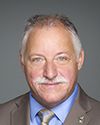Thank you.
Good morning, Mr. Chair, Mr. Vice-Chair, members of the committee.
My name is Elizabeth Douglas, Director General for Service Delivery Program Management for Veterans Affairs Canada.
I'm responsible for approximately 200 employees, located primarily in Charlottetown, in the areas of online services, strategic and enabling initiatives, case management and support services, health care programs, income support programs, rehabilitation services, vocational assistance, and long-term care.
I would like to thank you for the invitation to appear before the committee today. Joining me is Susan Baglole, the National Manager of Rehabilitation, Career Transition Services, and Income Support.
I'm also pleased to provide an overview of our rehabilitation services and vocational assistance program. I note that you emphasized the importance of vocational rehabilitation in your “Comparative Study of Services in Other Jurisdictions“ report and concur that workforce reintegration is one of the keys to successful transition. At VAC, the 2016 “Life After Service” study, conducted internally, identified that 52% of our veterans report easy or moderately easy adjustment to civilian life and that veterans who are employed have lower rates of difficulty with transition to civilian life.
Employment can impact health, social integration, and finances. Also, health, social integration, or financial problems can affect the ability to find or retain a job. Research shows clearly that participation in paid employment is beneficial to health. VAC's programs provide an opportunity to close this gap for Canadian Armed Forces personnel in their transition to civilian life. As we will discuss today, there are programs in place that are closing that seam.
Our LASS research shows that overall, veterans do well in the labour market, with 65% employed at the time of our last LASS study in 2016. In addition, 49% of veterans are able to transfer their military skills, knowledge, and abilities to comparable civilian occupations. Also, the unemployment rate for veterans is the same as that of the Canadian general population.
However, veterans are more likely to have activity limitations at work and to face barriers to labour force participation. Some veterans are retired and are not interested in working, while others are at school or pursuing other interests. However, 22% of those not in the labour force reported being on disability.
There are also other subpopulations who may have more difficulty in post-military employment success. These include women, those with fewer years of service, those who are younger, and those who served in the army. While veterans in general are doing well integrating into the civilian workforce, some still need support.
For those who are unable to transition successfully, VAC's rehabilitation services and vocational assistance program provide eligible veterans and their spouses or survivors with medical, psychosocial, and/or vocational services. The intent of the program is to support restoration of functioning in areas such as mental and physical functioning, social adjustment, family relationships, financial security, and employment.
Participants in the rehabilitation program often have complex needs in a number of areas and require medical, psychosocial, and/or vocational services. As of June 30, 2017, 12,245 veterans and 196 spouses or survivors benefited from rehabilitation services.
Vocational professionals work with the veteran to help them transfer skills and education to the civilian labour force. These vocational supports may include help to identify suitable employment, job search skills, resumé development, and financial support for training and related costs. In the first quarter of 2017-18, 76% of veterans were more employable upon completion of a vocational rehab plan.
Education and training may be an important part of a plan for some veterans. Through the rehabilitation program, veterans can access up to $75,800 for education and related costs. Veterans can work towards a university degree, attend a technical college, or partake in a variety of educational programs.
In most cases, rehab services are provided through a network of local experts. A VAC case manager works with the veteran and their family to help determine what is needed and how to access these services. On behalf of VAC, Canadian veterans vocational rehabilitation services provides the vocational rehabilitation and assistance to help the veteran build their vocational rehab plans and achieve their goals.
Shortly, you’ll hear from my CAF colleague about SISIP. Some veterans may be participating in VAC’s rehab program, receiving medical and psychosocial rehabilitation services while receiving vocational assistance from SISIP. CAF, VAC, and SISIP case managers work to coordinate these services across organizations.
There are significant efforts under way between the CAF and VAC to enhance transition and to align programs and services. The Prime Minister identified closing the seam between CAF and VAC by reducing complexity and strengthening partnerships as the first priority in the Minister of Veterans Affairs' mandate letter. In an effort to ensure CAF members, veterans, and their families have a successful transition from the military to civilian life, a CAF-VAC seamless transition task force was established in 2016.
Early engagement and intervention is one of the most critical components of a successful transition process from CAF. In 2016, in response to the June 2014 report of the Standing Committee on Veterans Affairs, we launched the CAF-VAC enhanced transition services. This initiative is about VAC engaging earlier with medically releasing VAC members and their families. This results in building stronger relationships with medically releasing members prior to release, the determination of eligibility for programs and services pre-release, and the strengthening of joint case management activities between CAF and VAC.
In conclusion, I want to note that every veteran is different. However, one unifying experience is the major life change that results from the journey to life after service. The most successful transitions occur when a veteran has a positive state of well-being, which is a balance of financial, mental, physical, and social factors. Financial security is critical, but financial security is just one of the domains essential to the overall well-being of the veteran.
The rehabilitation services and vocational assistance program provides individualized, needs-based services to veterans and their spouses and survivors. The program aims to support restoration of functioning in areas such as mental and physical, social adjustment, family relationships, financial security, and employment.
Thank you again for the invitation to speak to you today. I appreciate the opportunity to support the work of your committee and consider what it may hold for the future of Canada's services to veterans and families in the recognition of their extraordinary contributions and service.
Thank you.










